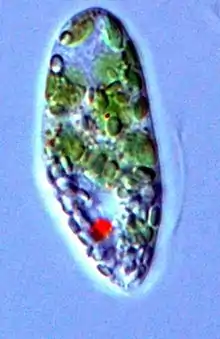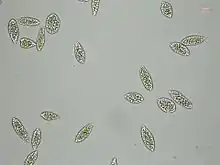| Euglena gracilis | |
|---|---|
 | |
| Scientific classification | |
| Domain: | Eukaryota |
| Phylum: | Euglenozoa |
| Class: | Euglenoidea |
| Order: | Euglenales |
| Family: | Euglenaceae |
| Genus: | Euglena |
| Species: | E. gracilis |
| Binomial name | |
| Euglena gracilis Klebs, 1883 | |
Euglena gracilis is a freshwater species of single-celled alga in the genus Euglena. It has secondary chloroplasts, and is a mixotroph able to feed by photosynthesis or phagocytosis. It has a highly flexible cell surface, allowing it to change shape from a thin cell up to 100 µm long, to a sphere of approximately 20 µm. Each cell has two flagella, only one of which emerges from the flagellar pocket (reservoir) in the anterior of the cell, and can move by swimming, or by so-called "euglenoid" movement across surfaces. E. gracilis has been used extensively in the laboratory as a model organism, particularly for studying cell biology, biochemistry.[1] Other areas of their use range from complex biological processes as photosynthesis, photoreception, phototaxic responses, nutritional studies and the relationship of molecular structure to the biological function of subcellular particles from a fundamental point of view.[2] Euglena gracilis, is the most studied member of the Euglenaceae.[3]
In recent years, Euglena has been found to be an excellent tool for investigations of fundamental biology and even as an aid in clinical diagnosis since they are used to measure vitamin B12 by bioassay.[2]
Euglena has several chloroplasts surrounded by three membranes and with pyrenoids. These chloroplasts are of green algal origin. The main storage product is paramylon, a β-1,3 polymer of glucose stored in the form of granules in the cytoplasm.[4] A red eyespot (stigma) is located near the base of the reservoir and this filters the light and focuses it on the paraflagellar body, and is involved in the phototaxis of this alga.[5]
Taxonomy

A morphological and molecular study of the Euglenozoa put E. gracilis in close kinship with the species Khawkinea quartana, with Peranema trichophorum basal to both,[6] although a later molecular analysis showed that E. gracilis was, in fact, more closely related to Astasia longa than to certain other species recognized as Euglena. The transcriptome of E. gracilis was recently sequenced, providing information about all of the genes that the organism is actively using. They found that E. gracilis has a whole host of new, unclassified genes which can make complex carbohydrates and natural products.[7][8]
References
- ↑ Russell, A. G.; Watanabe, Y; Charette, JM; Gray, MW (2005). "Unusual features of fibrillarin cDNA and gene structure in Euglena gracilis: Evolutionary conservation of core proteins and structural predictions for methylation-guide box C/D snoRNPs throughout the domain Eucarya". Nucleic Acids Research. 33 (9): 2781–91. doi:10.1093/nar/gki574. PMC 1126904. PMID 15894796.
- 1 2 Wacker, Warren E. C. (1962-09-29). "Euglena: An Experimental Organism for Biochemical and Biophysical Studies". JAMA: The Journal of the American Medical Association. 181 (13): 1150. doi:10.1001/jama.1962.03050390052015. ISSN 0098-7484.
- ↑ "Euglena gracilis - an overview | ScienceDirect Topics". www.sciencedirect.com. Retrieved 2023-10-28.
- ↑ Monfils, Anna K.; Triemer, Richard E.; Bellairs, Emily F. (2011-03-01). "Characterization of paramylon morphological diversity in photosynthetic euglenoids (Euglenales, Euglenophyta)". Phycologia. 50 (2): 156–169. doi:10.2216/09-112.1. ISSN 0031-8884.
- ↑ Häder, Donat-P.; Iseki, Mineo (2017), Schwartzbach, Steven D.; Shigeoka, Shigeru (eds.), "Photomovement in Euglena", Euglena: Biochemistry, Cell and Molecular Biology, Advances in Experimental Medicine and Biology, Cham: Springer International Publishing, pp. 207–235, doi:10.1007/978-3-319-54910-1_11, ISBN 978-3-319-54910-1, retrieved 2023-10-28
- ↑ Montegut-Felkner, Ann E.; Triemer, Richard E. (1997). "Phylogenetic Relationships of Selected Euglenoid Genera Based on Morphological and Molecular Data". Journal of Phycology. 33 (3): 512–9. doi:10.1111/j.0022-3646.1997.00512.x.
- ↑ The potential in your pond published on August 14, 2015 by the "John Innes Centre"
- ↑ O'Neill, Ellis C.; Trick, Martin; Hill, Lionel; Rejzek, Martin; Dusi, Renata G.; Hamilton, Christopher J.; Zimba, Paul V.; Henrissat, Bernard; Field, Robert A. (2015). "The transcriptome of Euglena gracilis reveals unexpected metabolic capabilities for carbohydrate and natural product biochemistry". Molecular BioSystems. 11 (10): 2808–21. doi:10.1039/C5MB00319A. PMID 26289754.
External links
 Media related to Euglena gracilis at Wikimedia Commons
Media related to Euglena gracilis at Wikimedia Commons